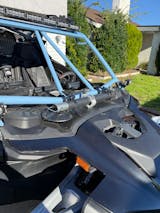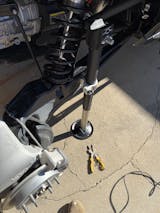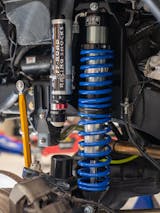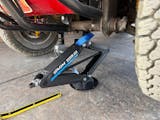Tires- the under-appreciated and often abused work horses of the road, have come a long way from the days of solid rubber. Today’s tires are a complex layering of materials. Imagine mixing steel, nylon, polyester and rubber to form a round object that must support the weight of a car, be responsible for many of the vehicle’s characteristics and if that wasn't enough you must also distribute the mass of all those components evenly around the tire, so its doesn't shake the vehicle apart as it spins down the road.(Ya there’s alot going on)

But tires weren't always this complex. In the early days of cars, tires were simple, solid, pieces of rubber and were more for traction and protecting the wheels than offering any kind of performance or comfort (today's wheel barrels offer better ride quality). The breakthrough came in 1888 when Scottish inventor John Boyd Dunlop (yes that Dunlop) created the pneumatic tire, providing motorists with a much smoother ride. A decade later Goodyear developed the Bias Ply tire. By the 1930s most vehicles were running these stout tires.

So what the heck is a bias ply tire, you ask.
Bias ply refers to how the cords that make up the carcass of the tire run from bead to bead.
Bias plies are arranged in a crisscross pattern at a diagonal (between 30-40 degrees from the direction of travel). With each layer running in the opposite direction from the one under , making an “X” pattern if you were able to look down through the layers. Most tires use 4, but you can have as many as 10 of these plies. Another fun fact - Bias ply tires use far more rubber in the sidewall, tread and between the plies than a radial tire, but are still far more flexible than radials, so they work great for off-road and drag applications. That extra rubber makes them more resistant to cuts and punctures. And they have better traction at low speeds and in straight-line travel because of how they conform to the terrain.

However, because they use so much rubber and are more flexible, they tend to roll-over on the sidewalls and lose traction in corners. The tread wears faster, and they have more rolling resistance. They also get flat spots if they sit too long. And not that I need to pile on, but they follow all the deformations in the ground, so bias plies feel like they wander more than radials on the road..
Lucky for us, Michelin created and commercialized the radial design, making them standard on their Citroen 2CV in 1948 (Actually the first radial designs were patented in 1914 and 1916. Those patents expired without ever being used though). By the mid 1970s all passenger cars and many trucks came from the factory with Radial tires.

So what makes a radial tire so much better?
Outside of high-load capacity, it’s that radial cords allow better flex. (Radial plies run 90-degree to the direction of travel from bead to bead or “radially” from the center of the tire out). That flex makes the tire act more like a spring, improving ride comfort even as the load rating is increased.. The feature also increases tire life and lets manufacturers run a wider and flatter footprint, increasing traction. The design also allows the sidewall and tread to function as 2 independent parts giving manufacturers a far greater ability to tune a tire's characteristics, than with a Bias ply that acts as a single unit. For off-road, radial tires can offer better flex and more grip in certain situations on the rocks and in sand.

Even with all the engineering poured into modern radial tires, it's still a balance… improve the ride, reduce performance, better grip, shorter life span and that's just the carcass and compounds. The tread design, including the angles and numbers of tread blocks, even the negative space between the blocks can have dramatic effects on the feel and performance of a tire.

As we roll into the future, engineers work to overcome these limitations and in turn continue to push the boundaries of tire technology. Run-flat tires, eco-friendly options, and airless tires are just a glimpse of what's to come. Electric vehicles bring new challenges, and tire manufacturers are adapting to meet the demands of a changing automotive landscape.

In conclusion, the history of the automotive tire is a gripping tale of innovation, from the solid rubber struggles to the high-tech wonders of today. So, the next time you hit the road, take a moment to appreciate those round marvels beneath your wheels – they've come a long way!
















